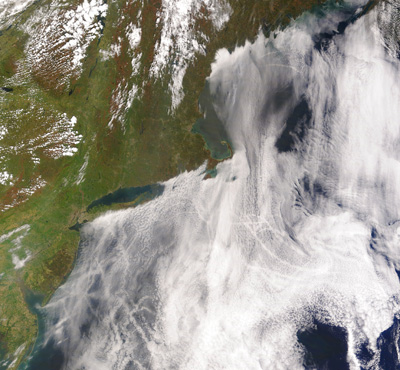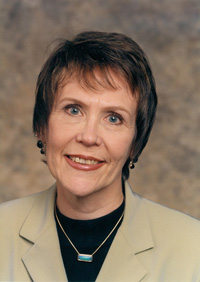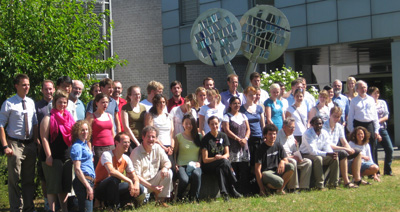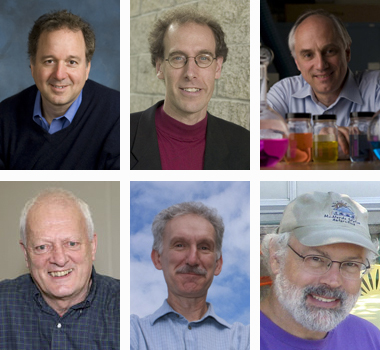Getting serious about geoengineering
Researchers, governments take a closer look at issues and technologies
Nov 2, 2010 - by Staff
Nov 2, 2010 - by Staff
2 November 2010 • A blossoming of interest in geoengineering research over the last few years has ripened into a deeper consideration of the topic by scientists, policymakers, and to a growing degree, the public. This interest has been boosted by a relative lack of action on mitigating climate change, as evidenced by the U.S. Senate’s failure to pass a climate bill in 2010 and by the lukewarm outcome of the United Nations’ 2009 climate summit in Copenhagen. If these trends are any indication, a global consensus on how to move ahead on mitigation may not occur for a long time.

Clouds off the U.S. East Coast on 11 May 2005 are thickened in streaks along the tracks of exhaust-emitting ships, as captured in this photo from the Moderate Resolution Imaging Spectroradiometer aboard NASA’s Terra satellite.
The idea of geoengineering, increasingly referred to as climate engineering—manipulating Earth’s climate to counteract greenhouse gas emissions—is gaining traction as a complement to mitigation and adaptation strategies for avoiding dangerous anthropogenic interference with the climate system. No large-scale technologies are currently in place, and it would likely require more than a decade of research to understand if any of the technologies will work and what environmental impacts might occur. Thus, a growing number of scientists and decision makers now support research and planning on climate engineering.
Weather modification, a prelude of sorts to geoengineering, came into vogue between the late 1940s through 1960s but faded as environmental and ethical concerns arose. Geoengineering was a background research topic until 2006, when Nobel Prize winner Paul Crutzen (Max Planck Institute for Chemistry) published one of a series of papers on geoengineering in a special issue of Climatic Change. In September of the same year, NCAR’s Tom Wigley published a paper in Sciencethat, like Crutzen’s, considered injecting sulfur gases to create particles in the stratosphere as a way to offset futurewarming. Both scientists characterized geoengineering as a way to buy time for society to develop CO2 mitigation strategies. (A 2006 article in UCAR Quarterly includes background on these papers and earlier efforts.)
The landscape in 2010
Today, geoengineering approaches are grouped into two camps: carbon dioxide removal (CDR) and solar radiation management (SRM). CDR focuses on removal of carbon dioxide from the atmosphere, such as through planting trees to enhance carbon uptake or developing technologies to store and capture carbon emitted by power plants. Direct removal of carbon tackles the cause of global warming directly and is relatively low in risk and uncertainties, but such techniques are unable to quickly reduce global temperature.
SRM methods are designed to reflect a small portion of incoming solar light (1% to 2%) back into space. The two most viable SRM techniques are stratospheric sulfur loading, which mimics the atmospheric effects of a volcanic eruption, and tropical cloud brightening, in which salt particles are injected into the troposphere to make clouds more reflective. SRM has the potential to lower global temperatures quickly in the event of a crisis. However, application of these techniques may cause new problems (for example, SRM may affect monsoon patterns in Asia). SRM techniques also mask global warming rather than address its root cause, and they do not directly deal with the downsides of increasing carbon emissions, such as ocean acidification and other major issues.

Climate engineering au naturel: Sun-blocking particles lofted into the stratosphere by the 1991 eruption of Mount Pinatubo in the Philippines dropped global temperature by up to 0.5°C (0.9°F) for more than a year. (Photo courtesy Dave Harlow/U.S. Geological Survey.)
In 2007, commercial plans gained momentum to experiment with dissolving iron at the ocean surface in remote, low-productivity ocean regions in order to stimulate phytoplankton growth. Such a technique could potentially lead to an increase in uptake of atmospheric carbon dioxide. After blooming, the phytoplankton die, sinking to the bottom of the ocean and taking with them some amount of photosynthesized carbon dioxide.
Among those expressing concern about the effectiveness and potential impacts of these large-scale plans are the scientific groups of the London Convention (LC) and London Protocol (LP). These global conventions protect the marine environment from human activities. In October 2008, the LC/LP governing bodies issued a resolution to disallow ocean fertilization activities, except in the case of legitimate scientific research; they asked their scientific groups, which for all practical purposes act as a single body, to establish a framework from which such research might be evaluated. That assessment framework was released in October 2010 by the LC/LP governing bodies. Notably, this is the first effort directed at developing international geoengineering governance.
“I think it likely that the LC/LP will ultimately opt for legally-binding regulation of ocean fertilization,” says Chris Vivian, chair of the LC/LP scientific groups and principal marine advisor at the U.K. Centre for Environment, Fisheries and Aquaculture Science.
Around the table and in the classroom
Geoengineering has become a topical fixture at annual meetings of several scientific societies, and a number of high-profile reports and gatherings have emerged over the last year. In September 2009, the UK Royal Society published a report on the issues surrounding geoengineering, finding that such technologies were very likely to be technically possible and, in some cases, potentially useful. However, the report also identified major uncertainties regarding their effectiveness, costs, and environmental impacts. In the wake of this report, a U.S. Congress–U.K. Parliament joint activity ran hearings to consider how geoengineering might be governed both domestically and internationally.
As they consider geoengineering, experts are drawing on other approaches to managing highly sensitive technologies that have global repercussions. In 1975, one of the first key meetings on the issues and ethics of recombinant DNA (the building blocks of genetic engineering) took place at Asilomar, a California retreat center. The meeting helped lead to development of safe and appropriate laboratory management methodologies.
Inspired by that conference, 175 specialists gathered at Asilomar in March 2010 for the International Conference on Climate Intervention Technologies. Aiming for breadth of input, the meeting included broadly equal numbers of representatives from the physical and social sciences, risk management, governance, ethics, law, economics, and business media. The conference was sponsored by the Climate Response Fund, founded in 2009 to foster discussion of such research and reduce the odds that geoengineering might be deployed prematurely. Attendees explored ways to minimize risks of both major forms of geoengineering—CDR and SRM—by outlining potential methodologies for initial research and regulation.

Margaret Leinen.
Among Asilomar’s outcomes is an upcoming report that will refine principles that emerged from the discussions, says Michael MacCracken, chief scientist for climate change at the Climate Institute and leader of Asilomar’s scientific organizing committee. The report will include guidelines for how geoengineering-oriented research should be integrated with—and how it is distinct from—other research. Among the intangible conference benefits, says MacCracken, was the assembly of a diverse group of people for constructive engagement on potentially contentious issues.
“The rich discussion that resulted from bringing together a variety of communities allowed all to see that scientists interested in climate engineering research share concern about its implications as well as its impacts,” notes Margaret Leinen, president of the Climate Response Fund. Since Asilomar, the fund has worked with a variety of groups interested in using the Asilomar Principles—a set of agreed-upon points that emerged from the conference—to enrich thinking about related research. The Royal Society intends to use the principles as one of the inputs to a study of SRM governance, and several governments have requested updates on the Asilomar Principles to better consider relevant implications on governance and conduct of research.
“Interest in climate engineering research is growing in several countries,” observes Leinen, “but clear messages coming from many directions indicate both that governance is necessary before experiments in nature should be conducted, and that governance mechanisms, ethics, economics, and social implications should be studied in addition to science and engineering.”
Academics are already examining climate engineering from this type of broad perspective at the University of Heidelberg’s Marsilius Kolleg research center, which has a distinct geoengineering focus. Most geoengineering analysis to date has been conducted by researchers moving into the field from other areas, says Ulrich Platt, director of Heidelberg’s Department of Environmental Physics. However, he adds, a new generation of specialists is being specifically cultivated at Marsilius Kolleg to address geoengineering’s many issues.
With funding from various national sources as well as from the European Union, a team of about two dozen interdisciplinary researchers and doctoral students is working on a comprehensive assessment of geoengineering, according to Platt. “They are taking into consideration the globalized economy, law, politics, and ethics, as well as scientific questions,” he says.

Participants in the 2010 Summer School on Global Governance of Climate Engineering. (Photo courtesy Alan Robock.)
As part of this effort, an international summer school on climate engineering was held in July in Heidelberg—the first of what conveners hope will be an annual event led by partners at Heidelberg, Carnegie Mellon University, and the University of Calgary. More than 40 students at the weeklong summer school considered climate engineering from the wide variety of perspectives represented by the student and faculty participants. The next summer school will be held in 2011 in Calgary.
Putting the models side by side
Climate modelers are also focusing their efforts with regard to geoengineering. Rutgers University will host the first meeting of the Geoengineering Model Intercomparison Project in early February 2011. The goal is to compare responses of various climate models to a common set of idealized SRM schemes, much as the Coupled Model Intercomparison Project has done for climate-change simulations.
“So far, different experiments have been run on different climate models,” explains Rutgers’ Alan Robock, who is among those planning the upcoming meeting. “At this meeting, we’ll begin to analyze the results from several climate modeling groups who are running a set of four model results and determine the robustness of various model responses.”
National and international interest in geoengineering is clearly gathering steam, with the American Geophysical Union, American Meteorological Society, and National Academy of Sciences, among others, calling for development of formal research programs. However, without an effective commitment to climate mitigation, MacCracken believes that climate engineering cannot—without very serious side effects—counter the impacts of a world in which greenhouse-gas emissions continue to rise.
“Building significantly toward actual field testing and exploratory deployment really only makes sense, at least to me, if the United States and other nations commit to significant near-term mitigation,” MacCracken says. “Otherwise it would be like having a few investigators trying to hold back an accelerating freight train.”
—Rachel Hauser and Nicole Gordon
Geoengineering as a last resort
Ken Caldeira, Carnegie Institution, Stanford University
Caldeira first heard about geoengineering in 1998 from Lowell Wood, a protégé of physicist Edward Teller. Lowell suggested placing particles high in the stratosphere, an idea that Caldeira didn’t think would work. In an effort to prove Lowell wrong, he ran simulations reflecting sunlight back into space; to his surprise, it worked, and Caldeira’s been researching geoengineering ever since, organizing several conferences on the topic. The most feasible approach, he says, would be to introduce sulfate particles into the upper atmosphere. He cautions that geoengineering should only be considered as a last resort, with reducing greenhouse gases the best course of action.
“Science can't tell us what we should do, but it can help us to understand the consequences of possible actions. Only when values are combined with science, can we determine whether those actions should be regarded as beneficial or harmful. The stakes are simply too high for us to think that ignorance is a good policy.”

Six experts on geoengineering: (top row) Ken Caldeira, David Keith, and Klaus Lackner; (bottom row) John Latham, Phil Rasch, and Alan Robock.
Bridging climate science, geoengineering,
and public policy
David Keith, University of Calgary
A former NCAR postdoc, Keith has been thinking aboutgeoengineering since the early 1990s, when he wrote one of the first comparative assessments of the subject in journal literature, “A Serious Look at Geoengineering” (Eos, 1992). His current research focuses on the economics of geoengineering, aspects of engineered aerosols, methods for delivering materials to the stratosphere, and direct capture of carbon dioxide from the atmosphere. Keith has suggested a method that could enable particles that reflect sunlight to be placed in the mesosphere, as opposed to the stratosphere (where such particles may interfere with ozone).
"The hard part about these technologies for managing solar radiation is not science, it is governing the stunning power that these technologies grant us in a multipolar world. We need to develop institutions that that are capable of making legitimate decisions about large-scale testing or deployment of climate engineering technologies."
Genuine plastic trees
Klaus Lackner, Columbia University
Lackner was inspired to start working on the concept of artificial trees in 1999, even helping his junior high daughter with a science fair project to capture carbon dioxide from the air. His device, which he calls the “air extractor,” sucks carbon from the atmosphere about 1,000 times more efficiently than a real tree. As wind blows though plastic leaves, the carbon gets trapped in a chamber, compressed, and turned into liquid carbon dioxide, which can be stored underground or transformed into carbonate rock. The extractors could come in sizes ranging from a television set to a small building and be placed anywhere.
“Small units in large numbers can make a big difference.”
Sunscreen from seawater
John Latham, NCAR
Latham faced some scorn in 1990 when he first proposed the idea of tinkering with marine clouds to offset global warming. In recent years, his geoengineering idea has steadily received more positive attention; the UK Royal Society has recommended that research into the idea be funded. Latham proposes to seed maritime stratocumulus clouds with large quantities of small seawater particles that would act as cloud condensation nuclei, leading to the production of additional cloud droplets, thereby making clouds brighter so that they would reflect more sunlight back into space. Increasing marine cloud reflectivity by about 10% would produce a cooling sufficient to balance the warming resulting from a doubling of carbon dioxide levels in the atmosphere, according to Latham.
“We hope that geoengineering—a dreadfully provocative word—will never be needed, but we have little confidence that adequate fossil-fuel burning reduction will occur in time to stave off highly adverse consequences. We think it responsible to conduct research into ideas that hold the possibility of deferring major global temperature rise for long enough to develop a clean source of energy, on a global scale.”
A climate modeler weighs in
Phil Rasch, Pacific Northwest National Laboratory
Rasch, a longtime developer of NCAR community models, testified on geoengineering to the House Subcommittee on Energy and Environment last February, saying that much more research is required before geoengineering deployment could be considered. Initially, a small federally funded program for research is desirable, he says; if promising strategies emerge and geoengineering seems needed, an activity on the scale of the Manhattan Project would probably be required to thoroughly vet the consequences before deployment. The ethical, moral, and political issues associated with geoengineering are also critical.Rasch has applied his climate modeling skills to evaluating different geoengineering proposals and analyzing the regional and seasonal effects that stratospheric aerosol injections might have on climate. Recently, he’s been studying how ships might affect the reflectivity of clouds by seeding them with sea salt particles.
“Geoengineering is not a great or long-term solution for countering climate change. It is far better to find a sustainable solution that eliminates anthropogenic emissions of greenhouse gases. But geoengineering might be used to buy some time and avoid some of the consequences of emissions while we make a transition to that sustainable solution. I am interested in thinking through these options ahead of time, rather than at the last minute.”
A strong voice of caution
Alan Robock, Rutgers University
Robock evaluates the effectiveness and possible consequences of stratospheric geoengineering proposals, with an eye toward the benefits, risks, and costs. He cautions that, far from being a magic solution to global warming, the path of geoengineering may be even more dangerous. It would do nothing to stop ocean acidification and could destroy ozone and produce regional droughts, he points out. Different nations may find it impossible to agree on who controls Earth’s temperature, and control over the technology could fall into the wrong hands.
“We must redouble our efforts to shift our economies to a post-carbon world. So long as governments begin to push the world in this direction, we have a good chance to lessen the impacts of global warming on our planet without geoengineering.”